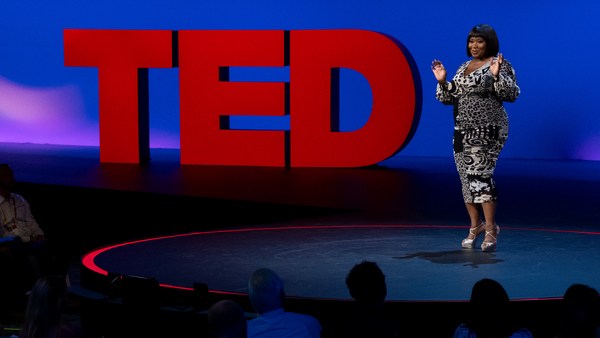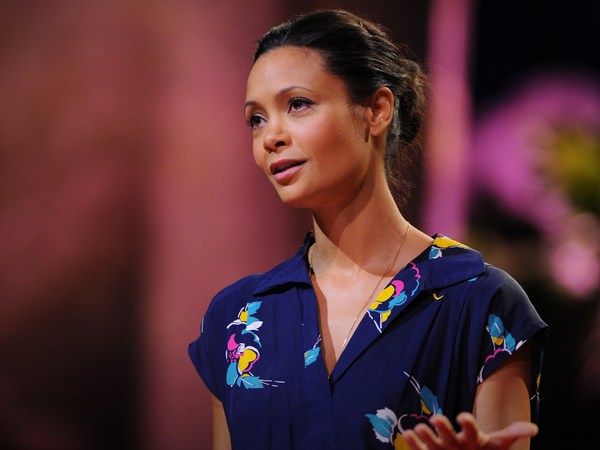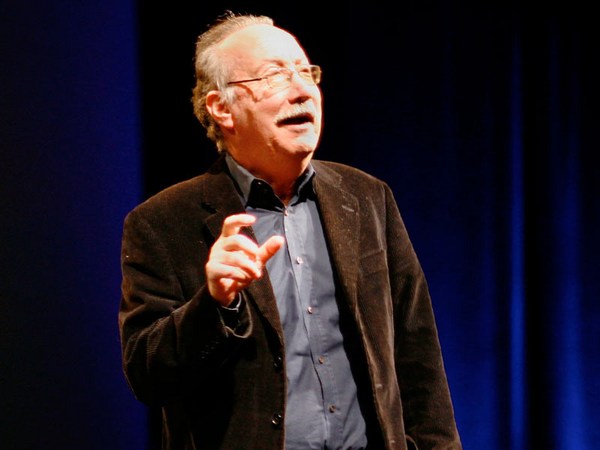(Singing) I am an endangered species
(Applause and cheers)
But I sing no victim song.
I am a woman.
I am an artist.
And I know where my voice ... belongs.
(Applause and cheers)
Now, you might have heard me sing that song. It was September 12th, 2022, right after Amy Poehler and Seth Meyers said, "And the winner is, Sheryl Lee Ralph!" What!? I had just won the Emmy Award for Best Supporting Actress in a comedy for my role as Mrs. Barbara Howard on your favorite TV show, "Abbott Elementary."
(Cheers)
Oh, yes. And I was shocked. As the children would say, shooketh into disbelief. Oh, my goodness, it was my first time at the Emmys and I won. Yes! And I got to tell you, in that moment, I was so stunned into disbelief that I don't know how I got up on the stage. There I was, just listening to that roar of applause. Mm mm mm. And my whole career flashed right there in front of me. Starting with 19-year-old Sheryl Lee in her first movie being directed by the great Sidney Poitier. Oh, yeah, you can clap that.
(Applause)
Followed by ten years of “no” after “no” after “no.” Before the next film role came about. But I filled in that time with TV and more "nos" and more rejection until I made it big on Broadway in what has become the iconic musical of the '80s, because I say so,
(Laughter)
"Dreamgirls."
(Applause)
And boy, did I learn a lot of life lessons there. And I mean, after so many moments of doubt, disbelief, there I was, on that Emmy stage, with this huge sign in front of me flashing "Stop now," "Stop now," "Stop now." And I started to think, “My God, what if I had stopped after all of those ‘nos?’ What if I had stopped after all of those moments of feeling defeated? What if I had stopped?" I wouldn't be standing there for that golden moment.
But right now, many of us, we are feeling ... deeply challenged trying to hold on and believe in ourselves, and I do not mean in a toxic way. I am talking about a way that comes from confidence, the kind of confidence that can keep us moving forward when we are feeling like we are carrying the weight of the pandemic, trying to figure out all of this political division, fighting all of the mental, physical, social violence in our homes, in our communities, to climate change, social media. It's a lot. Making it hard to believe in the goodness in the world. And harder still to believe in the goodness of ourselves. This is a rough time, people, and our mental health is suffering. We all need a checkup from the neck up.
(Laughter)
And I don't mean -- yeah, it's OK. You feel me, thank you.
(Applause)
And I don't mean just medicine. I actually mean reframing our thinking of our ability to believe in ourselves.
Now I know, you see me on TV, in magazines, on movie screens, and you might be thinking to yourself, "What does she know about struggling to believe in herself?" Well, let me tell you something. I do not look like my journey.
(Laughter)
(Applause)
Oh, I've been through a few things. And the struggle is real. But I have learned something in my life. That there are three things that we all must do in order to believe in ourselves.
Number one. First, we need to see ourselves. I mean, really, truly, deeply see ourselves for who and what we are in order to believe in ourselves. I’m a child of the ’60s, and that was hard. Oh. In the third grade, I tested out of public school into a fancy private school where the only Black person I saw every day was the one who looked back at me in the mirror. I was by myself, and I was all alone. And the things that were said to me, and I'm not talking about just the kids, but the adults, too. And when I would come home from school crying the ugly cry, my immigrant Jamaican mother would sit me down in front of the mirror and ask me, "Do you see an N-word? Do you see a liar? Do you see a big-lip monkey? No! So dry your eyes. And when you go back to school, remember, you are rubber, they are glue. And every ignorant thing they say about you bounces off of you and sticks to them."
(Applause)
And I believed her. And it didn't hurt. So much. Because I believed.
Number two. We've got to think. Think about ourselves in order to believe in ourselves. Growing up, my dad had a sign on his desk. And it said, "Think." "Think." Oh, I did not know how valuable and powerful the simple act of thinking was until I came back to Hollywood from my triumphant run on Broadway, and I had this meeting with a big studio Hollywood casting director. Oh, I was so excited. I walked in and he looked at me and he said, "Hm. Everybody knows you're a beautiful, talented Black girl. But what do I do with a beautiful, talented Black girl? Do I put you in a movie with Tom Cruise? Does he kiss you? Ugh. Who goes to see that movie?"
(Laughs)
I could not believe that that man had just said that to me, to my face. And he hurt me. He hurt me so deeply, I was actually thinking about quitting. Until ... I started to think. And I thought about what he said. He said that everybody knew that I was a beautiful, talented Black girl.
(Laughter)
(Cheers and applause)
And that I deserve to be cast in movies with the likes of Tom Cruise, and he should kiss me.
(Applause)
(Laughs)
So what was meant to break me did not break me, it built me up. I believed that man, I believed what he said. And I walked out of there giving myself permission to take up space in Hollywood, knowing that I belonged there no matter what anybody thought about me.
(Cheers and applause)
Thirdly. We've got to act like we believe in ourselves. Oh, yeah. Because when we believe in ourselves and act on it, we create possibilities that never would have been possible had we not just believed. OK, so I will tell you another story. I will never forget walking into one of those crowded Hollywood rooms, and I see Harry Thomason, producer Harry Thomason, who is married to Linda Bloodworth-Thomason, writer, creator of the series "Designing Women." I walk right up to Harry and I say, "How can it be, that after all of these years Anthony has not had a relationship with a Black woman? After all, the show takes place in Atlanta, Georgia."
(Laughter)
He looked at me, took a step back and said, "Who are you?" I said, "I'm Sheryl Lee Ralph." And he said, "OK. Have your people call my people and we will see what we can do."
And guess what happened?
(Laughter)
I got cast as Etienne Toussaint Bouvier, Las Vegas showgirl turned Anthony's wife for the final season of "Designing Women."
(Cheers and applause)
Oh, yeah.
Against all odds, once again, I gave myself permission to take up space, believing that I belonged. I believed that if Sheryl Lee did the work of honing her craft, building solid relationships and stayed ready so she didn't have to get ready, anything was possible. Heck, winning an Emmy. A Grammy. An Oscar. A Tony. EGOT it, baby.
(Cheering)
So ... When you leave this room today, I challenge all of you to start a meaningful practice of looking in the mirror and loving what you see. Believe in what you see.
If you can't love it, then respect it. And if you can't respect it, then encourage it. If you can't encourage it, empower it. And if you can't empower it, please be kind to it.
(Applause)
The greatest relationship, the greatest one you will ever have is with yourself. Believe me. Have faith in yourself. Believing that faith can make broken wings fly. And we deserve to soar. Remember, maybe one of these days when you pass the mirror and you catch a glimpse of yourself, remember, I told you this. That is what believing looks like. And don't you ever, ever, ever give up on you.
I am Sheryl Lee Ralph, and I love you just the way you are.
(Singing) Believe in yourself
As I believe in you
Thank you.
(Cheers and applause)




